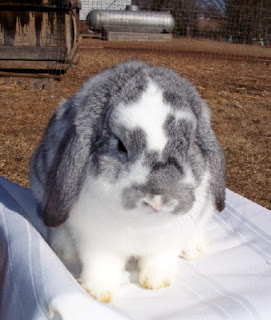After feeding everyone this morning, I loaded up Hollywood and Dallas and a Bourbon Red turkey that I had sold, and headed to the rabbit show.
There were hundreds of rabbits at the show, from tiny dwarves to the huge Flemish Giants to the Angoras who look like cotton balls with eyes. Everyone has their favorite breed or breeds. The people and judges are so nice and everything is very laid back. For the most part, you have prepared your rabbits before the show, so once you are there, it is mainly a matter of listening to make sure that you don't miss your class.
Dallas is young for his age group and is also really a breeding stock quality rabbit so he did not place at all. The judges did like his short body and build, but his head is a little long and his crown is a little narrow.
Hollywood's classes only had two rabbits, including him and the other rabbit was older and nicer. The judges did like Hollywood's shoulders and haunches and felt he would improve with age. He was also losing his baby coat and while the hair was not flying loose, his color was patchy.
No rabbit is perfect, so the you take what you learn and try to use that knowledge to improve your herd. So the best doe to breed to Dallas will have good head and crown. Dallas is currently bred to three different does, all a little different and all with different strengthes and weaknesses.
 |
| Narrow Gate Farm Flower, senior Chinchilla Holland Lop doe |
One of the does that he is bred to is Flower. She is a little bit older and probably will not have as many kits as a young doe, but I think that she will be a good cross with him.






















